How To Draw Different Eyes Step By Step
- Abode
- Portrait Cartoon
- Learn to Describe Optics
Learn to Describe Eyes (Convincingly!):
The 6 Most Common Mistakes to Avoid
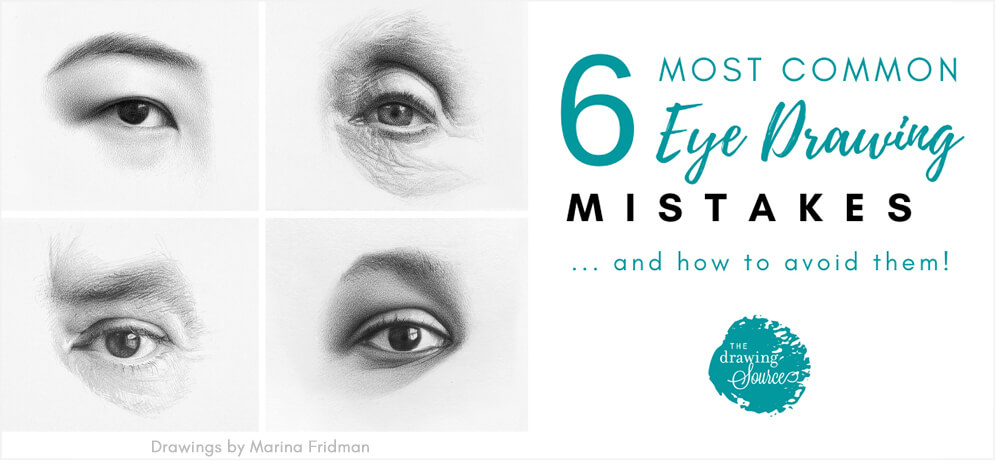
What does it have to larn to describe eyes convincingly and realistically?
As a follow-up to my step past pace centre drawing tutorial, in this article I'll point out what I've noticed to exist the six near common mistakes that backbite from the realism and naturalism of an eye drawing.
(In a hurry? Download a PDF version of this guide here!)
![]()
Acquire to Draw Eyes
Fault 1: Assuming that eyes are a generic almond shape (and drawing them that way!)
Let me analyze – it's not that eyes aren't at all almond-shaped. The issue is that assuming that optics are almond-shaped often leads to generic-looking drawings. If y'all take watched Lesson 2 of my Mini-Course , you know how important the specificity of shapes is to creating a likeness of your subject field.
Optics are no exception! To learn to draw eyes convincingly, so that look recognizably similar those of our model, nosotros must pay attention to where specific angle changes occur. Look how distinctly unique all of these eye shapes are:
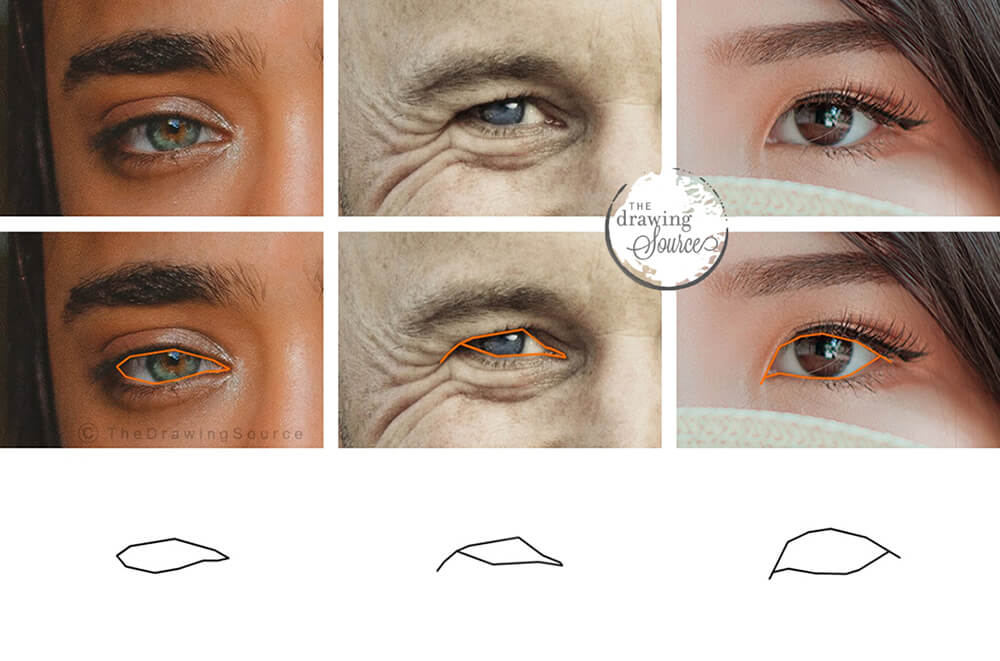
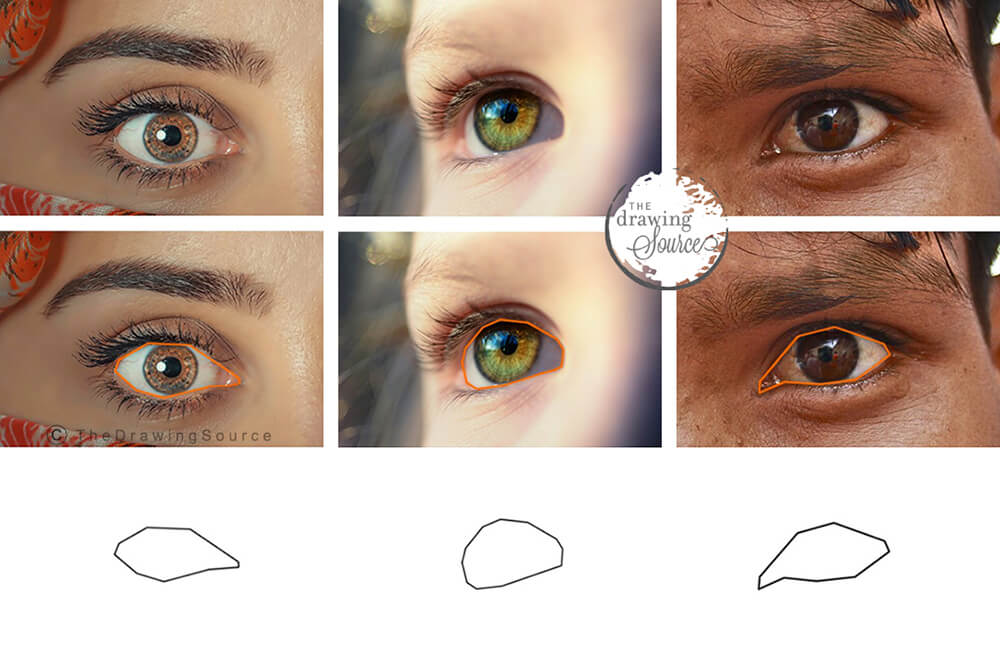 Larn to depict optics convincingly past paying attention to the specificity of each individual eye shape
Larn to depict optics convincingly past paying attention to the specificity of each individual eye shape
Just 'almond-shaped'? I think non! 'Almond-shaped' doesn't practice justice to the complexity of this feature.
The best mode to avoid this pitfall is to brainstorm your drawing with direct lines, with which yous can point the specific angle changes that occur throughout the eye (as I do in my eye cartoon tutorial).
Fault ii: Leaving the 'white of the eye' completely white
The sclera, more ordinarily known equally the 'white of the eye', is rarely completely white!
Because the eyeball is a sphere, the sclera commonly has a gradation and a range of values. It is essential to observe and depict this range of values in order to create the illusion that the eyeball is, indeed, spherical and dimensional. Take a await at the many subtle value shifts present in the scleras of these eyes:
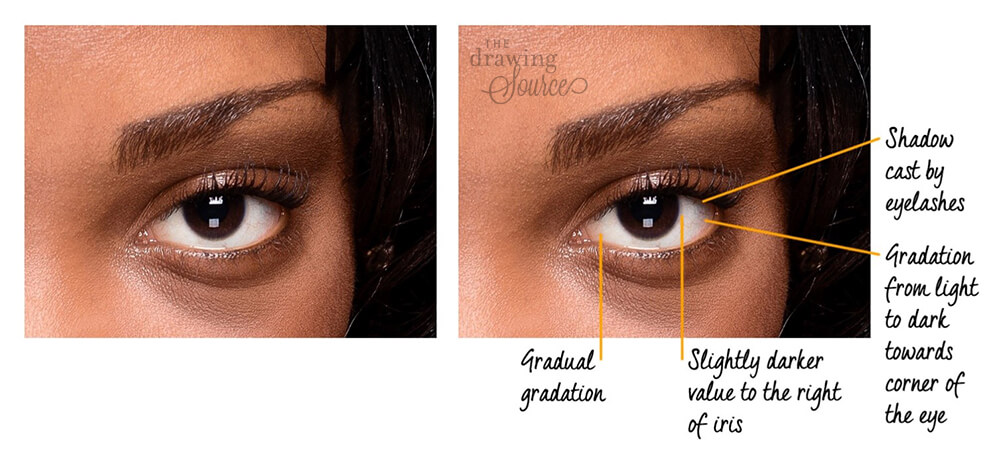
Fifty-fifty when the sclera looks white at first glance, upon closer observation you will brainstorm to come across differences in value. For example, in the eye above notice the gradual gradations from the lighter center of the eye, to a slight shadow towards both corners of the middle. In that location is also a slightly darker value merely to the correct of the iris, and a deep shadow cast by the eyelashes.
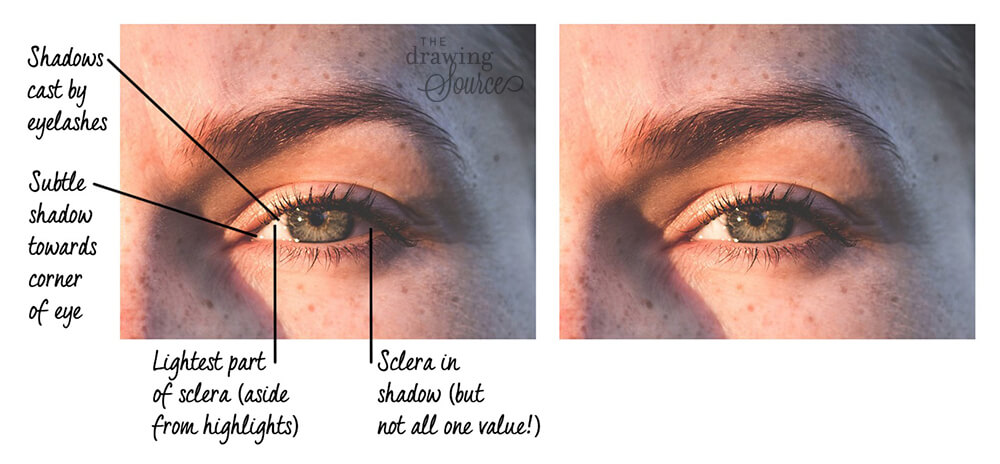 Acquire to draw eyes convincingly by noticing the subtle value changes within the sclera
Acquire to draw eyes convincingly by noticing the subtle value changes within the sclera
In other cases, one half of the sclera may be more than evidently in shadow. All the same, even when this is the case, discover the gradations and value differences within the shadow area!
Fault iii: Not noticing the 'thickness' of the upper and lower eyelids (not creating a front and top plane)
The upper and lower eyelids take a 'thickness'. This gives them two important planes that we demand to notice and describe in our drawings.
The upper eyelid has a front airplane and a bottom aeroplane. The lower eyelid has a front aeroplane and a top airplane. How much we see of these planes depends mostly on the position of the model's caput (though factors such as the shape of the eye, age and the tautness of the pare can play a role as well).
When observing an heart, information technology can be tricky to decide what it is that we're seeing (not to mention to depict information technology accurately!) This is why we study its construction – so that we know what to look for when observing the eye, and are then able to 'hint' at its planes and features subtly in our drawings.
Mistake 4: Drawing details earlier establishing the value structure
There are so many seductive details in an centre! Of course nosotros all desire to draw eyelashes, eyebrows and the cute, radiating fibres of an iris. However, these details will never make your cartoon expect realistic if you take non first successfully established a value structure.
'Value structure' refers to where the light, half-tone and shadow areas are on your discipline , as depicted below. Sentry Lesson five of my Mini-Course to learn how to plant an effective value construction in your cartoon!
When drawing an middle, retrieve to piece of work 'from general to specific', and to first address the larger value relationships before delving into the details.
Fault five: Not grouping eyelashes and eyebrows (and drawing eyelashes too evenly!)
Eyebrows and eyelashes are rarely evenly spaced and the same length.
To draw them realistically, instead of drawing in each hair individually, look for groupings or shapes to simplify them into, as in the epitome below:
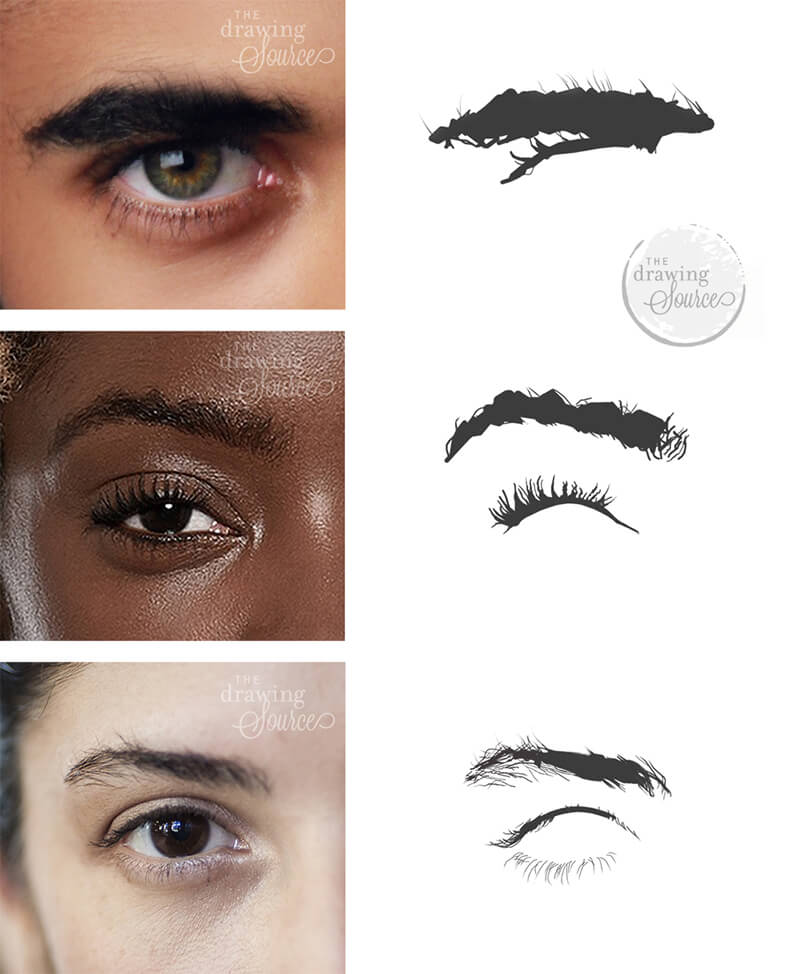
Then, add some stray strands where they are most noticeable, and voila! Find that where there are several individual eyelashes (like the bottom fix of eyelashes in the image to a higher place), they are not evenly spaced, are not the same length, practise not face up the same management, and have various angle changes! They're not perfect! Drawing them this way will add naturalism to your portrait.
(Bank check out my tutorial on drawing realistic eyebrows here!)
Mistake half-dozen: Making all the edges sharp/not varying the edge quality throughout your drawing
Look at the diverseness of edge qualities in the middle below!
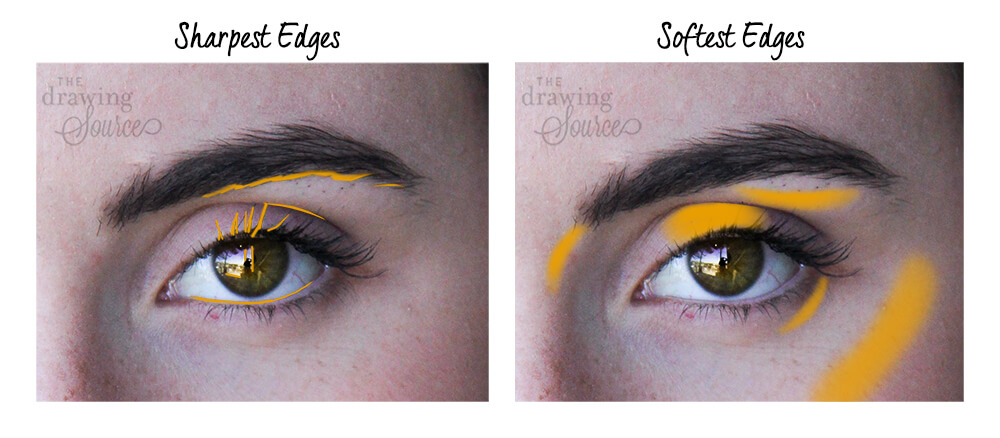
A common mistake when drawing eyes is making all of the edges precipitous. Finding your sharpest edges, softest edges, and different degrees of edge qualities between the ii extremes is key to creating depth, dimension and realism in your centre drawing.
In that location you accept it! The six most common mistakes when drawing eyes.
Ways to proceed to acquire to draw eyes:
- Take a look at your latest eye cartoon, become through this list (y'all tin can download it below!), and run into if in that location are any improvements y'all tin can make
- Check out my eye cartoon tutorial, download the reference photograph and draw along with me
- View this tutorial on cartoon realistic eyebrows (in that location are middle drawing tips at that place, too!)
- For further center-cartoon instruction, stay tuned for an upcoming, in-depth class on the subject!
Downloadable Resources:
Happy Drawing,
![]()
Enjoyed this page? Please share it!
Share buttons and pinnable image below:
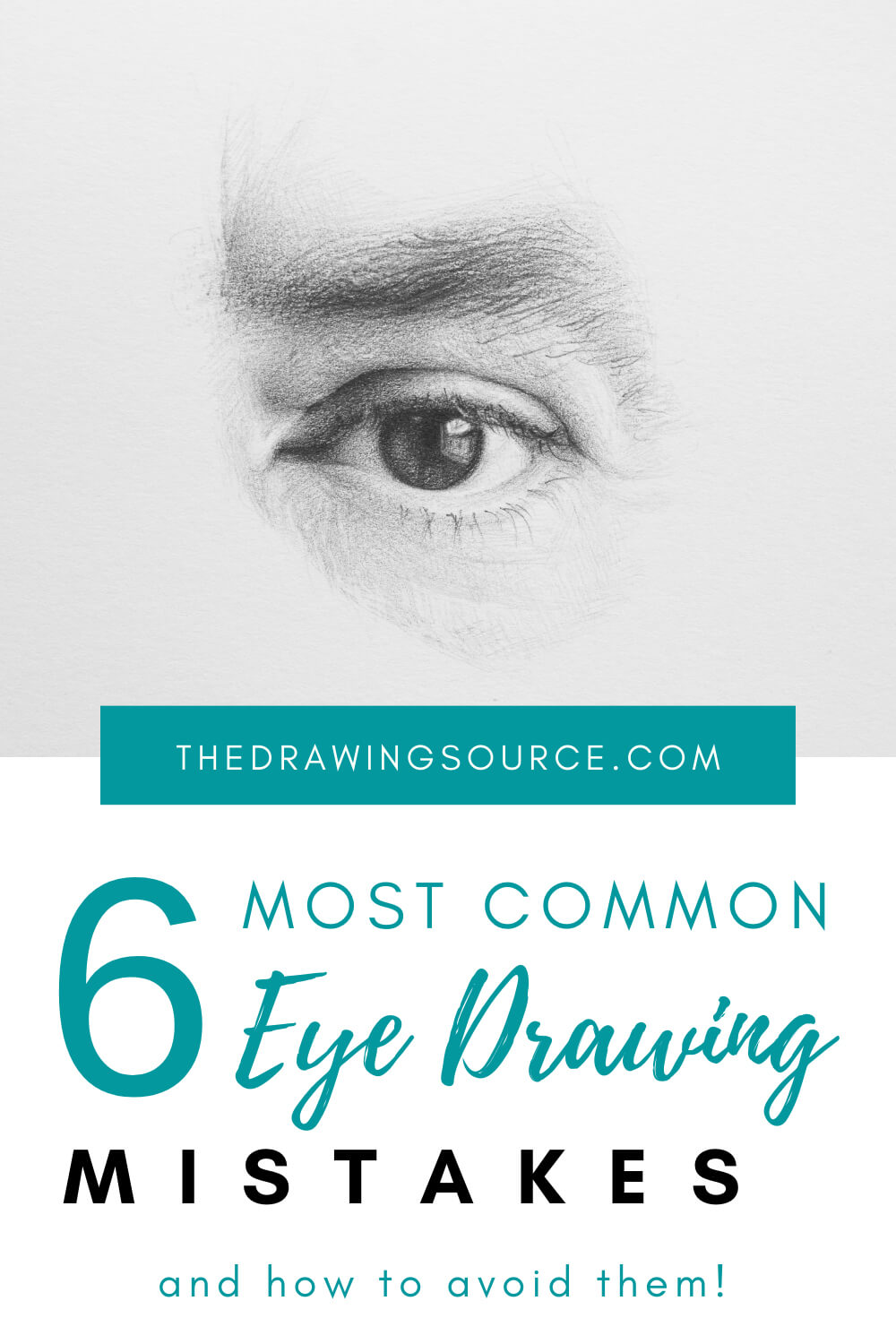
If you enjoyed this folio, y'all may also be interested in:
Related Pages
How to Draw Realistic Eyes (Step past Step Tutorial)
How to Draw Eyebrows (Pace by Step)
How to Draw Realistic Lips (Stride by Step)
How to Describe an Ear on Toned Paper (Step by Stride)
Step by Pace Portrait Drawing Tutorial
Return to Portrait Drawing from Learn to Depict Optics
How To Draw Different Eyes Step By Step,
Source: https://www.thedrawingsource.com/learn-to-draw-eyes.html
Posted by: englesdoony1936.blogspot.com


0 Response to "How To Draw Different Eyes Step By Step"
Post a Comment